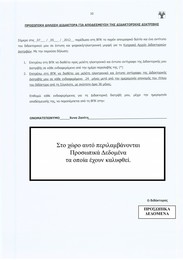Peer interaction and cognitive development : the role of gender at 6-7 and 10-11 years old

View/
Date
2012-05Author
Zapiti, Anna St.Publisher
Πανεπιστήμιο Κύπρου, Σχολή Κοινωνικών Επιστημών και Επιστημών Αγωγής / University of Cyprus, Faculty of Social Sciences and EducationPlace of publication
ΚύπροςCyprus
Google Scholar check
Keyword(s):
Metadata
Show full item recordAbstract
Η διδακτορική διατριβή διερεύνησε την επίδραση του φύλου ως ασυμμετρία στις αλληλεπιδράσεις των παιδιών. Στην έρευνα συμμετείχαν παιδιά από δύο διαφορετικές ηλικιακές ομάδες (6-7 και 10-11 χρονών) με σκοπό να διερευνηθεί κατά πόσο η επίδραση του φύλου στις αλληλεπιδράσεις μικρότερων και μεγαλύτερων παιδιών. Το θεωρητικό υπόβαθρο αυτής της δουλειάς αποτελούν οι τρεις γενεές ερευνών που ξεκίνησαν από τη Γενεύη πριν από 30 χρόνια περίπου.
Η έρευνα ακολούθησε το σχεδιασμό προ-τεστ, αλληλεπίδραση, μετά-τεστ. Τα παιδιά έπρεπε να επιλύσουν ένα χωροταξικό έργο πρώτα ατομικά, μετά σε ζευγάρια με ένα παιδί που είχε καλύτερη ή χειρότερη επίδοση από αυτά στο προ-τεστ (έτσι ώστε στα ζευγάρια να μπαίνουν πάντα παιδιά διαφορετικού αναπτυξιακού επιπέδου) και τέλος έλυναν το έργο ξανά ατομικά αμέσως μετά την αλληλεπίδραση (άμεσο μετά –τεστ) και δύο βδομάδες μετά (μετέπειτα μετά-τεστ). Τα μικρότερα παιδιά είχαν να λύσουν δύο τεστ που μετρούσαν τη γνώση τους για το κοινωνικό μαρκάρισμα των παιχνιδιών σε σχέση με το φύλο. Τα μεγαλύτερα παιδιά συμπλήρωσαν ένα ερωτηματολόγιο που μετρούσε συναισθήματα κατά την αλληλεπίδραση με μέλη του αντίθετου φύλου καθώς και στάσεις και στερεότυπα για το αντίθετο φύλο. Ο σκοπός αυτών των μετρήσεων ήταν η διερεύνηση της σχέσης μεταξύ ταυτότητας του φύλου, συμπεριφοράς στην αλληλεπίδραση και γνωστικής προόδου.
Τα αποτελέσματα έδειξαν ότι στα μικρότερα παιδιά, το φύλο έχει επίδραση στη συμπεριφορά και στις στρατηγικές που χρησιμοποιούν. Μπορεί κάθε ζευγάρι να έχει κοινό στόχο την επίλυση του προβλήματος όμως η συμπεριφορά των παιδιών φαίνεται να συνδέεται με τις διαφορετικές κοινωνικές αναπαραστάσεις του φύλου. Αυτή όμως η επίδραση του φύλου φάνηκε ότι μειώνεται με την ηλικία. Αυτό δε σημαίνει ότι δεν επηρεάζει τις αλληλεπιδράσεις μεγαλύτερων παιδιών αλλά ότι το φύλο δεν έχει τόσο έκδηλη επίδραση στη συμπεριφορά. Παρόλα αυτά, κάποια μεγαλύτερα παιδιά παραμένουν με κάποιες στερεοτυπικές αντιλήψεις και σε αυτά τα παιδιά παρατηρείται κάποια επίδραση του φύλου στη γνωστική τους πρόοδο. Επομένως το φύλο ίσως δεν επηρεάζει τη συμπεριφορά αλλά μπορεί να επηρεάσει στο επίπεδο της αφηρημένης σκέψης. Τα ευρήματα συζητούνται με βάση προϋπάρχουσες έρευνες και θεωρίες. This PhD thesis explored the role of gender and expertise as asymmetries in the interactions of children. Children from two different age groups participated in the study (6-7 and 10-11 years old) in order to explore the role played by gender identity dynamics in the interactions of children of these two age groups. This work draws theoretically from the three generations of studies on peer interaction and cognitive development that initiated in Geneva more than thirty years ago.
The study followed the pre-test, interaction, immediate and delayed post-test design. Children have to solve a spatial task individually, then they work in pairs with a partner who was more or less advance in his/her knowledge over the task (so that pairs include children of different levels of expertise) and finally they try again to solve the task individually the same day the interaction takes place (immediate post-test) and two weeks later (delayed post-test). The younger children also were administered with two tests assessing their understanding of the gender marking of toys and conceptual understanding of an interrelationship between sex-group membership and gender marking of material culture. The children of the fifth grade had to complete a questionnaire which examined the way they cope with interaction with members of the opposite gender, attitudes and stereotypes for the members of the other gender group and strength of gender identity. These gender measures were included in order to investigate the relation between varieties of gender identity and behaviour in the interaction as well as the relation between different positioning on gender identity and outcome measures.
The results revealed that for younger children, gender clearly relates to their behavioural patterns and strategies in the interaction. Children may share the same goal but their behaviour is shaped by the social representations of gender that they bring in the interaction. In the interactions of older children (10-11 years old), gender was not found to relate directly to children’s behaviour. In fact, gender effect was found to diminish with age even though some children remain highly stereotyped. For these children, gender knowledge and identity was related to their outcomes indicating that when gender has an effect this is on the level of mental action. The findings are discussed in the light of existing theories and previous studies.
